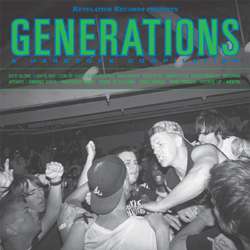Detailing the history of southern California punk of the late 1970s and early ‘80s and in particular, the scene that revolved around the legendary Cuckoo’s Nest club which hosted live music shows, the 2012 documentary Clockwork Orange County: The Rise of West Coast Punk Rock! (which earlier had been released under the title of We Were Feared) covers a fascinating topic yet suffers from the fact that although it’s fine to watch, it’s not an especially great movie by any stretch. Seeming to have been cobbled together relatively quickly in a manner that’s undeniably bland, the documentary relies heavily on a never-ending string of interviews with the musicians, skaters, and various other people who were around to experience the explosion of California punk. While it’s sometimes amusing to tag along on this trip down memory lane and listen to the various stories the interview subjects have to tell, Clockwork Orange County doesn’t offer up any sort of major revelation in the end and more often than not, plays like a cinematic pat on the back for Cuckoo’s Nest owner Jerry Roach.
The documentary is broken into short sections, each of which reveal information about the Orange County punk scene’s most notorious venue. Situated between a liquor store and a bar catering to the "redneck" crowd, the Cuckoo’s Nest was the place where numerous California punk groups got their start and made a name for themselves. It also was one of the most controversial businesses in the region, known for attracting a mischievous and increasingly violent sort of local riffraff. The unflattering reputation of the club ultimately led to legal problems for owner Roach, and the Nest eventually was shuttered when it became apparent that patrons could and would be arrested just for showing up at the place. Clockwork Orange County does a fine job of presenting the oral history of the venue from its early incarnation as a traditional music venue through to its importance as the birthplace of California punk and hardcore. Various stories told during the documentary firmly establish the setting the story takes place in and give insight into the mindsets that prevailed during those days. The differences between the punk scene circa 1980 and the one that exists today is one of the underlying themes of the film, though the idea is not explored as fully as one might desire.
Perhaps the best aspect of the documentary is that director Jonathan W.C. Mills has assembled a veritable who’s who of California punk scene personalities. Circle Jerks’ Keith Morris, Black Flag’s Henry Rollins, Dead Kennedys’ Jello Biafra and numerous other notable figures appear onscreen to offer up their perspective on the scene. Since the film lacks any sort of narration, we get the story directly from the mouths of the people who lived it, and the various tales told are often quite comical - the person conducting the interviews seems to be enjoying himself immensely since he’s often heard chuckling off-camera. Another highlight of the film is its use of grainy, black and white archival film footage shot at the Cuckoo’s Nest during its heyday. A mixture of location and concert footage along with backstage interviews which were appropriated from the 1981 documentary Urban Struggle: The Battle of the Cuckoo's Nest, this vintage material adds a much-needed sense of authenticity and credibility to a film that otherwise relies almost exclusively on talking heads.
It’s apparent when watching this documentary that it was a labor of love for the filmmakers, but unfortunately their enthusiasm can’t hide the fact that this movie looks and feels cheap, suffering from some glaring technical problems even in its final release version. It’s safe to say that not much imagination or inspiration went into the construction of this film: the whole thing is rather unpolished, providing exactly what a viewer would expect and nothing more. Audio levels throughout the program vary quite a bit, and distracting imperfections and glitches show up sporadically, particularly during the interviews with TSOL’s Jack Grisham. I consulted a few other reviews of the film to find out if this was just me or was an error with the production itself and it seems to be an issue that’s present across the board. While I would think and hope this error would be corrected at some point, it’s frankly unacceptable for a film that’s been sent out for distribution to suffer from these sorts of issues – the problem only speaks more to the fact that the documentary was thrown together hastily.
I’ve also got to say that it’s very odd that the documentary actually features precious little of the music it deals with – a quartet of scratchy concert sequences (two from Circle Jerks, one each from TSOL and Black Flag) provide the film’s only representation of actual California punk music. Mind you, these live performances from 1979 and '80 perfectly capture the energy and attitude of the times and are very cool to see. TSOL’s Greg Kuehn provides a murmuring instrumental soundtrack that establishes an appropriate mood for the documentary to play out in front of, but a viewer going into this film expecting to hear more of the tunes from the bands featured in it might be very disappointed. Ultimately, it’s the sense of intimacy provided by the vivid first-person accounts and the gritty, vintage footage that makes Clockwork Orange County compelling even if it’s noticeably dull from a stylistic point of view and glaringly imperfect from a technical one. Even if I’d have a hard time calling this the definitive story of Southern California punk, it nonetheless would work perfectly for the crowd it’s designed for.




